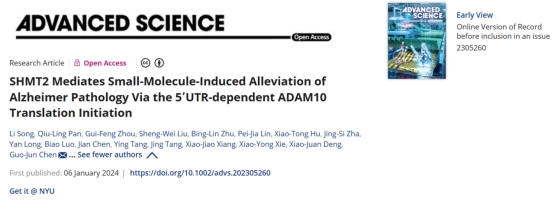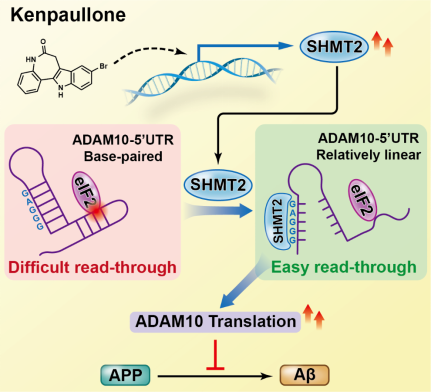On January 6, 2024, Professor CHEN Guojun’s team from the Chongqing Key Laboratory of Major Neuropsychiatric Diseases of the First Affiliated Hospital of Chongqing Medical University published the latest research article titled “SHMT2 mediates small-molecule-induced alleviation of Alzheimer pathology via the 5’UTR-dependent ADAM10 translation initiation” in the internationally renowned journal Advanced Science.

Alzheimer’s disease (AD), as the most common neurodegenerative disease, has complex pathogenesis and very limited treatment options, and has become a worldwide public health problem. The deposition of β-amyloid protein (Aβ) has been confirmed to be one of the most important pathological characteristics of AD. Therapeutic strategies to reduce Aβ deposition have always been an important direction in AD research. Therefore, ADAM10, a key enzyme that reduces the production of Aβ, has become an extremely valuable drug target.

Through high-throughput screening, Professor CHEN’s team discovered Kenpaullone (KEN), a small molecule compound that can promote the expression of ADAM10, which improves the cognitive function of AD model mice. Further mechanism research found that KEN works by promoting the moonlighting function of the one-carbon metabolic, i.e. enzyme mitochondrial serine hydroxymethyltransferase 2 (SHMT2). As an RNA-binding protein, SHMT2 specifically binds to the GAGGG sequence, causing structural changes in the 5’ untranslated region (5’UTR) of ADAM10, enhancing ribosome binding to this region, and promoting the translation initiation of the ADAM10 protein. This study laid a solid foundation for the potential value of the small molecule compound KEN in the treatment of AD.
Original article link: https://doi.org/10.1002/advs.202305260